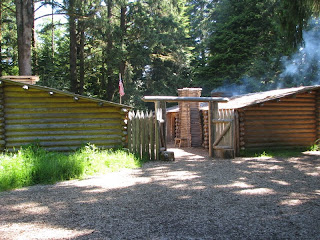May 21, 2024 – Natchez Trace Parkway, Mississippi and Alabama
Tuesday morning, we resumed our tour of the Parkway. We stopped at a few historical sites that only had signs telling you what used to be there so there was nothing to take pictures of. We stopped at the Parkway Visitor Center where we watched a short film on the Trace. We also bought a couple of Natchez Trace Parkway T-shirts
We then hiked another
section of the Old Trace.
The trail took us to the gravesites of 13 unknown Confererate soldiers. Tradition holds that the graves belong to Confererate soldiers who marched and camped along this stretch of the Old Trace. The grave markers face toward the Trace so travelers might read and remember.
The original grave markers may have
borne names, but they disappeared long ago.
In 1940 Senator Theodore Bilbo arranged for marble headstones, but they
were stolen. The National Park Service
erected the headstones now in place.
Our next
stop was Dogwood Valley where we took another short hike on the original Trace –
this section was sunken.
This section of the Trace passes
through a small valley with a stand of large dogwood trees.
Our next stop was at Donivan Slough
where a short trail took us through a lowland that supports a variety of large,
water-tolerant trees including tulip poplar, sycamore, and water oak.
Bald-cypress thrive in the swampy
backwaters of a “slue” or channel winding through the bottomland.
We stopped at Pharr Mounds, the largest and most important archaeological site in northern Mississippi. Eight large dome-shaped burial mounds are scattered over 90 acres. These mounds were built and used about 1–200 A.D. by a tribe of nomadic Indian hunters and gatherers who returned to this site at times to bury the dead with their possessions.
We ate a picnic lunch here before
continuing up the Parkway.
We stopped at a display about the Tennessee Tombigbee
Waterway. As early as 1810 the importance
of a waterway between the Tennessee River and the Tombigbee River was
recognized. But it wasn’t until 1972
that construction was started, and the waterway was completed in 1985. The Tennessee Tombigbee Waterway provides shallow
draft boats and barges access to some 16,000 miles of navigable inland
waterways with access to the Gulf of Mexico at Mobile, Alabama. The Waterway is 234 miles long with 149 miles
of river, 46 miles of canal and 39 miles of divide cut. Commodities shipped on the waterway include
ores, chemicals, farm products, paper and pulp, minerals and primary metals,
coal, and staples for manufacture and export.
Our next stop was at Cave Spring, a
natural cave that was created by underground water dissolving the rock.
The roof of this room was eventually weakened and
collapsed.
The spring was beautiful. Indians may have used it for drinking water,
but it is now unsafe to drink.
We crossed the state line into
Alabama and stopped at the Freedom Hills Overlook. We hiked a short but steep hill to the
overlook.
We got a beautiful view from the overlook, which is the highest point on the parkway in Alabama at 800 feet.
George Colbert operated a ferry across the Tennessee River from 1800-1819. His stand or inn offered travelers a warm meal and shelter during their journey on the Old Trace. Colbert looked out for his own well-being and once charged Andrew Jackson $75,000 to ferry his Tennessee army across the river. We can now cross the river on the John Coffee Memorial Bridge. General Coffee served with distinction under General Andrew Jackson in the War of 1812. Jackson and Coffee used the Natchez Trace and Colbert’s Ferry for troop movements during the war. In 1817 Coffee was appointed Surveyor General of the Mississippi Territory. Coffee’s Hickory Hill Plantation site is located a few miles from here.
We hiked a short trail along Colbert
Creek to Rock Spring.
We crossed Colbert Creek on some
steppingstones. Tacky took one plunge
into the shallow creek before he got the hang of using the stones.
We found a number of turtles is this
pond created by abandoned beaver dams.
This turtle is sitting on the log sunning himself. There is another turtle in the water below the
log but you can’t see it in the picture.
Rock Spring flows year-round with an
average temperature of 590F.
On our way back to Davis Lake we stopped at the site of a Chickasaw village. There was no information about this village at the site.
This was a long day and we have now completed about another 100 miles of the Natchez Trace Parkway to mile
marker 330.
.JPG)
.JPG)
.JPG)
.JPG)
.JPG)
.JPG)
.JPG)
.JPG)
.JPG)
.JPG)
.JPG)
.JPG)
.JPG)
.JPG)
.JPG)
.JPG)
.JPG)
.JPG)
.JPG)
.JPG)
.JPG)

.JPG)

Comments
Post a Comment